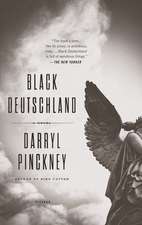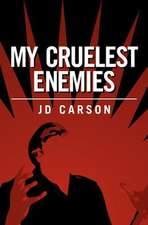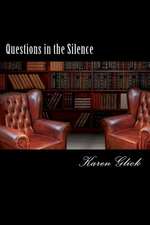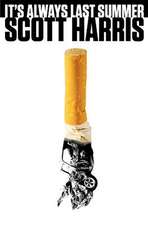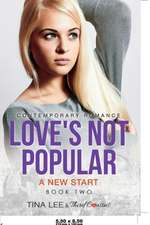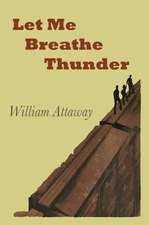Blood on the Forge: New York Review Books Classics
Autor William Attaway Darryl Pinckneyen Limba Engleză Paperback – 31 dec 2004
Blood on the Forge was first published in 1941, when it attracted the admiring attention of Richard Wright and Ralph Ellison. It is an indispensable account of a major turning point in black history, as well as a triumph of individual style, charged with the concentrated power and poignance of the blues.
Din seria New York Review Books Classics
-
 Preț: 88.86 lei
Preț: 88.86 lei -
 Preț: 98.73 lei
Preț: 98.73 lei - 16%
 Preț: 79.25 lei
Preț: 79.25 lei -
 Preț: 77.73 lei
Preț: 77.73 lei -
 Preț: 124.55 lei
Preț: 124.55 lei -
 Preț: 85.16 lei
Preț: 85.16 lei -
 Preț: 83.30 lei
Preț: 83.30 lei -
 Preț: 182.08 lei
Preț: 182.08 lei -
 Preț: 102.47 lei
Preț: 102.47 lei -
 Preț: 76.97 lei
Preț: 76.97 lei -
 Preț: 174.64 lei
Preț: 174.64 lei -
 Preț: 110.73 lei
Preț: 110.73 lei -
 Preț: 119.57 lei
Preț: 119.57 lei -
 Preț: 94.01 lei
Preț: 94.01 lei -
 Preț: 96.42 lei
Preț: 96.42 lei -
 Preț: 101.24 lei
Preț: 101.24 lei -
 Preț: 85.97 lei
Preț: 85.97 lei -
 Preț: 142.67 lei
Preț: 142.67 lei -
 Preț: 102.25 lei
Preț: 102.25 lei -
 Preț: 103.29 lei
Preț: 103.29 lei -
 Preț: 113.30 lei
Preț: 113.30 lei -
 Preț: 100.59 lei
Preț: 100.59 lei -
 Preț: 126.41 lei
Preț: 126.41 lei -
 Preț: 107.40 lei
Preț: 107.40 lei -
 Preț: 174.03 lei
Preț: 174.03 lei -
 Preț: 107.44 lei
Preț: 107.44 lei -
 Preț: 89.27 lei
Preț: 89.27 lei -
 Preț: 85.34 lei
Preț: 85.34 lei -
 Preț: 90.09 lei
Preț: 90.09 lei -
 Preț: 87.20 lei
Preț: 87.20 lei -
 Preț: 99.60 lei
Preț: 99.60 lei -
 Preț: 119.36 lei
Preț: 119.36 lei -
 Preț: 98.73 lei
Preț: 98.73 lei -
 Preț: 133.18 lei
Preț: 133.18 lei -
 Preț: 136.91 lei
Preț: 136.91 lei -
 Preț: 105.17 lei
Preț: 105.17 lei -
 Preț: 161.86 lei
Preț: 161.86 lei -
 Preț: 90.72 lei
Preț: 90.72 lei -
 Preț: 88.86 lei
Preț: 88.86 lei -
 Preț: 94.83 lei
Preț: 94.83 lei -
 Preț: 120.63 lei
Preț: 120.63 lei -
 Preț: 111.96 lei
Preț: 111.96 lei -
 Preț: 95.45 lei
Preț: 95.45 lei -
 Preț: 97.50 lei
Preț: 97.50 lei -
 Preț: 109.26 lei
Preț: 109.26 lei -
 Preț: 81.66 lei
Preț: 81.66 lei -
 Preț: 100.18 lei
Preț: 100.18 lei -
 Preț: 75.23 lei
Preț: 75.23 lei -
 Preț: 91.13 lei
Preț: 91.13 lei -
 Preț: 94.86 lei
Preț: 94.86 lei
Preț: 112.69 lei
Nou
Puncte Express: 169
Preț estimativ în valută:
21.57€ • 22.43$ • 18.07£
21.57€ • 22.43$ • 18.07£
Carte disponibilă
Livrare economică 20 februarie-06 martie
Livrare express 05-11 februarie pentru 20.23 lei
Preluare comenzi: 021 569.72.76
Specificații
ISBN-13: 9781590171349
ISBN-10: 1590171349
Pagini: 264
Dimensiuni: 127 x 201 x 18 mm
Greutate: 0.25 kg
Editura: NEW YORK REVIEW OF BOOKS
Seria New York Review Books Classics
ISBN-10: 1590171349
Pagini: 264
Dimensiuni: 127 x 201 x 18 mm
Greutate: 0.25 kg
Editura: NEW YORK REVIEW OF BOOKS
Seria New York Review Books Classics
Notă biografică
William Attaway (1911ߝ1986) was born in Mississippi, the son of a physician who moved his family to Chicago to escape the segregated South. Attaway was an indifferent student in high school, but after hearing a Langston Hughes poem read in class and discovering that Hughes was black, he was inspired with an urgent ambition to write. Rebelling against his middle-class origins, Attaway dropped out of the University of Illinois and spent some time as a hobo before returning to complete his college degree in 1936. He then worked variously as a seaman, a salesman, a union organizer, and as part of the Federal Writers’ Project, where he made friends with Richard Wright. Attaway moved to New York, published his first novel, Let Me Breathe Thunder (1939), the story of two white vagrants traveling with a young Mexican boy, and quickly followed it with Blood on the Forge (1941), about the fate of three African-American brothers in the Great Migration to the North. Attaway never produced another novel, but went on to prosper as a writer of radio and television scripts, screenplays, and numerous songs, including the “Banana Boat Song (Day-O),” which was a hit for his friend Harry Belafonte. A resident for many years of Barbados, Attaway returned to the United States toward the end of his life. He died in Los Angeles while working on a script.
Darryl Pinckney is the author of a novel, High Cotton, and, in the Alain Locke Lecture Series, Out There: Mavericks of Black Literature.
Darryl Pinckney is the author of a novel, High Cotton, and, in the Alain Locke Lecture Series, Out There: Mavericks of Black Literature.
Recenzii
"In his Blood on the Forge, William Attaway presents with skill the impact of industrial life on the simple black folk who fled the plantations of the South….[I]t will add…a new and better knowledge of American civilization. The reality that Attaway depicts is not beautiful, but it is none the less moving and human for that." —Richard Wright
"Spanning two areas and eras of Negro experience, those of the semi-feudal plantation and the industrial urban environment, Attaway’s source material receives its dynamic movement from the clash of two modes of economic production. The characters are caught in the force of a struggle which, like the steel furnace, roars throughout its pages….Attaway has proven himself one of the most gifted Negro writers." —Ralph Ellison
"Spanning two areas and eras of Negro experience, those of the semi-feudal plantation and the industrial urban environment, Attaway’s source material receives its dynamic movement from the clash of two modes of economic production. The characters are caught in the force of a struggle which, like the steel furnace, roars throughout its pages….Attaway has proven himself one of the most gifted Negro writers." —Ralph Ellison




